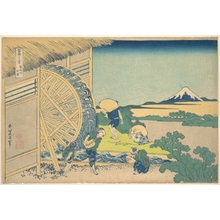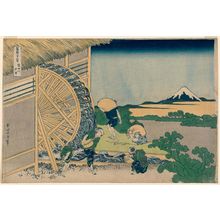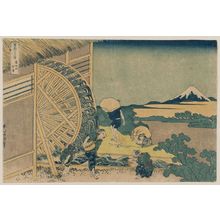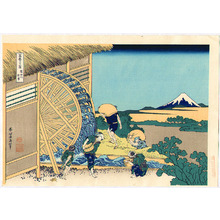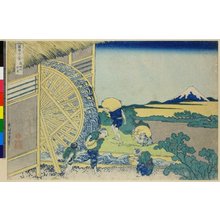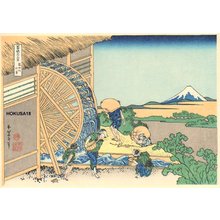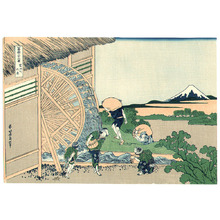葛飾北斎による浮世絵「Waterwheel at Onden」
作者:葛飾北斎
作品名:Waterwheel at Onden
制作年:c. 1830-1834
詳細:詳細情報...
情報源:ホノルル美術館
浮世絵(全 5,476 件)を表示...
説明:
Hokusai's print is full of action, depicting four farmers hard at work. The stylized water also adds vitality and motion to the scene. Hokusai was one of the pioneer artists to apply Western techniques (in this case, Western perspective) to Japanese art. This blending of traditional, stylized depiction along with Western perspective would become a trademark of Hokusai's style. (from Nostalgic Japan exhibition (6/8/2005-) - - - - - - - - - - - - In this print, Hokusai contrasts the activities of people completely absorbed in their task with Mount Fuji, remote and untouched by the human condition. In his time, mills for hulling rice were powered by the waters of the Shibuya River in Onden. Located between Harajuku and Aoyama, now one of the posh centers of Tokyo, Onden was still a sparsely populated rural area in Hokusai’s time. Nearly the entire left half of the picture is occupied by the mill’s waterwheel. This wheel carries water into a wooden flume that cuts horizontally across the foreground. Two farmers carry in sacks of unhulled rice; women are washing hulled rice in the water of the flume. A little boy, bored, leads his pet turtle on a string to the water. No one is conscious of Mount Fuji – they are all too busy with their labors. This print clearly exhibits Hokusai’s tendency to dissect his surroundings, whether natural or human, into geometrical forms and reassemble them into a coherent composition: rectangles of the mill and flume, the wheel’s semicircle, the triangle of Fuji, and the round shapes of heads, sacks, and rice tubs. The gestures of the workers recall figures in his sketchbooks, the Hokusai Manga. The key-block was printed in blue; the publisher’s and the censor’s seal appear at the lower left. (The Asian Art Museum of San Francisco, HOKUSAI AND HIROSHIGE – Great Japanese Prints from the James A. Michener Collection, Honolulu Academy of Arts: The Asian Art Museum of San Francisco, 1998 Page 80. Cat. 31) ****************** In this print, Hokusai once again reveals his penchant for scenes taken from daily life. Two women wash hulled rice in the foreground, while on the other side of the flume two men bring sacks of unhulled rice to the mill. A boy with a pet turtle on a leash watches to the side. Like many similar prints in the Thirty-six Views, the people are preoccupied with their tasks, oblivious to the splendor of the volcano in the distance. Now one of the most fashionable districts in Tokyo, Onden was located on the Shibuya River between Harajuku and Aoyama. “Hokusai’s Summit: Thirty-six Views of Mount Fuji” (09/24/2009-01/06/2010) ******************************
類似の浮世絵


